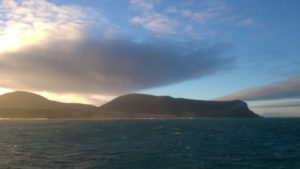Have you ever had the opportunity to peer at some of the many online depictions of Ptolemy’s 2nd Century AD Geography? You’ll have had to turn your head to one side in order to take in the northern-most extent of Scotland, including the Northern Isles; bent over and squeezed to fit into the realm of what was then believed to be the ‘known world’? The idea that anything might survive beyond the 59th parallel was, it seems, impossible to consider for Ptolemy and his Graeco-Roman counterparts and so they simply ensured that the Orcades and their farther flung partner archipelago, Ultima Thule (today’s Shetland), were snuck in below their true latitudes.
Perhaps you have also read recent press and social media reports of archaeological findings at the Ness of Brodgar, or even reviews of BBC Television’s Orkney: Britain’s Ancient Capital? Both proclaim aspects of the Islands’ heritage to be ‘weird’ and create the inference that there may be life in the far north, but ‘it’s not as we know it’. More making strange and a framing of the north as remote in culture as well as location.
In reality, experiencing life, and working, in the Northern Isles, does, indeed, require a re-framing of mindset. For example: Edinburgh seems a terribly remote location from this centre, after all it takes me a car journey, a ferry, a train and another train and all in more than one day allows, to get to Edinburgh. How does anyone down there cope with being so far from everything up here?

The view over the island of Hoy

Kirkwall Harbour
Ah yes, the re-framing is welcome and it is enabling me to explore and research the ways in which being constrained as peripheral and, in some ways, ‘exotically traditional’ may actually inspire creative innovation. I am already observing this in the ways that islanders are curating and developing their maritime heritage – this being the topic that is significant for my PhD. In an environment where the sea is always adjacent and imminent and where most people relate to the sea directly, each day, I’m also aware that this ‘heritage’ can be both past, present and future. It ullulates; an ongoing wave of cultural expressions; from the wrecked to being renewed boats, set adrift across the islands, to my own growing obsession with the Shipping Forecast as I plan field-tripping from one island to another. The experience is rich and I hope this will be reflected in my research. All this and next month: Shetland. It’s a great privilege to be representing this northerly reach of the IRC, here at 59°N and counting!
Cait is researching Curating Heritage for Sustainable Communities in Highly Vulnerable Environments: The Case of Scotland’s Northern Isles, an Applied Research Collaborative Studentship supported PhD, supervised in partnership across Heriot-Watt University, The University of the Highlands and Islands Centre for Nordic Studies and Shetland Museum and Archives. She is based at the university’s Orkney Campus, the International Centre for Island Technology.

Interior of the boat shed at Lyness on Scapa Flow
